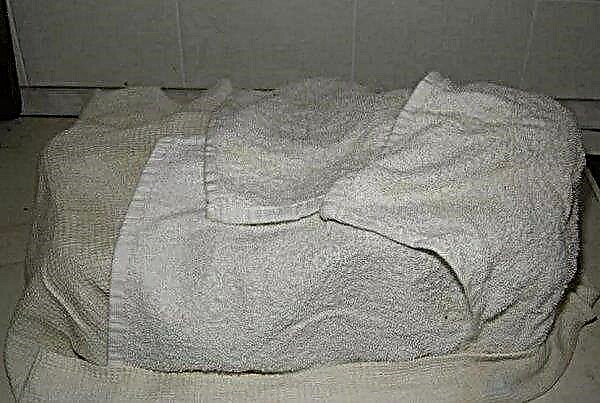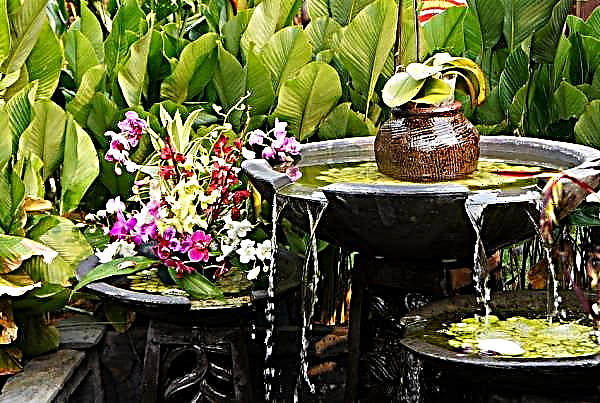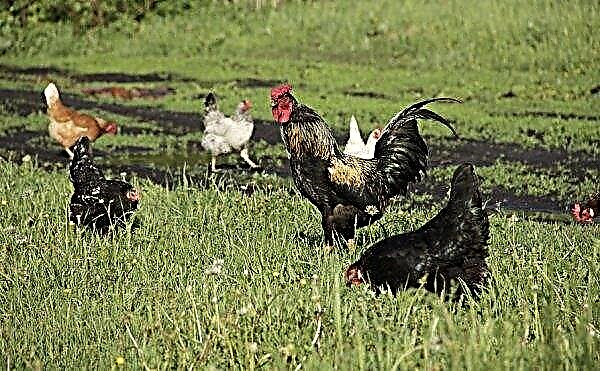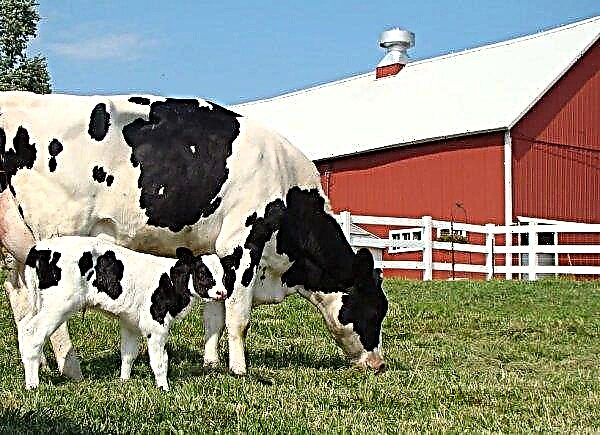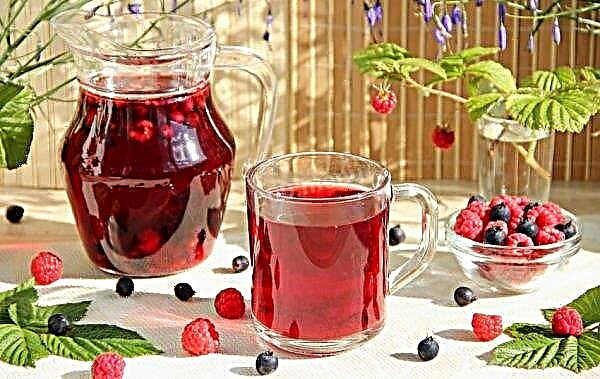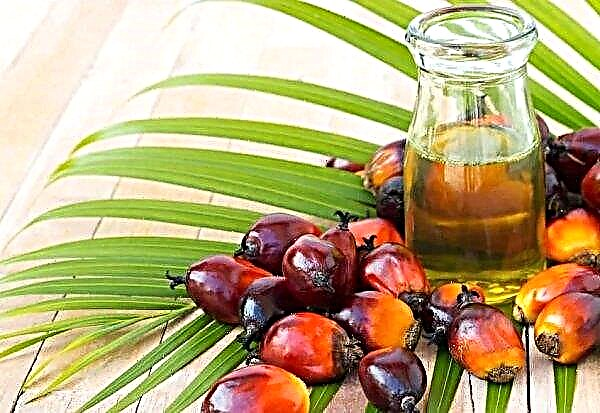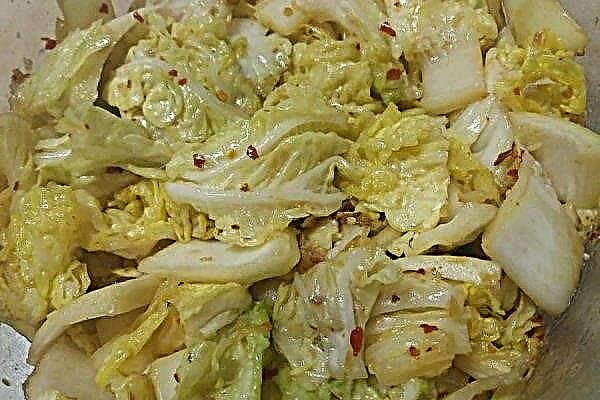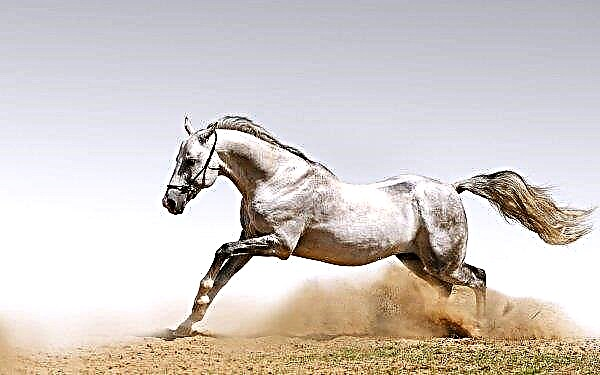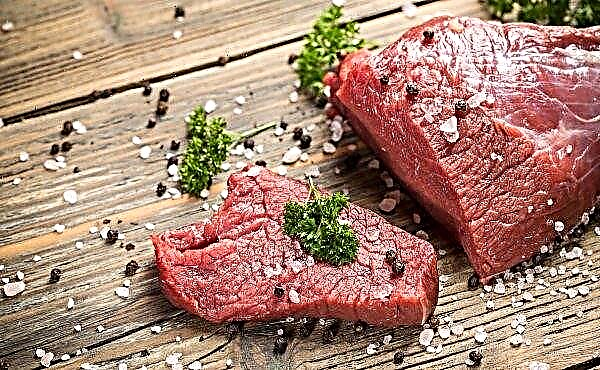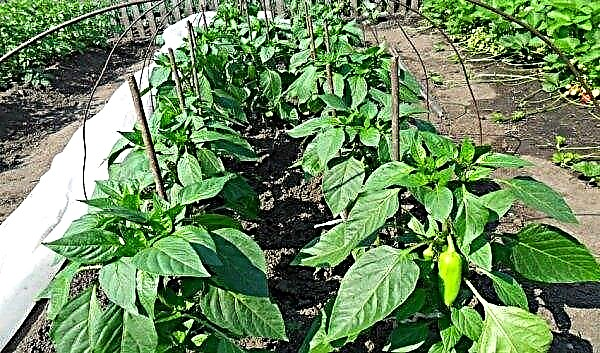Many gardeners decided to grow one of the varieties of onions in their house plots - multi-tiered onions. The reason is not only the decorative appearance of the plant, but also its frost resistance, antiseptic and anthelmintic qualities, as well as the ability to give early greens with minimal labor. In the article we will talk about what it is - a multi-tiered onion, as well as about the secrets of growing, caring and preserving the harvest of this amazing culture.
Description and characteristics of onions
The plant in question is a perennial herbaceous photophilous hybrid culture from the Onion family.
Did you know? Green onion has a slight analgesic effect when bitten by a wasp or bee. To relieve pain, you must immediately rub the juice of green feathers in a bitten place (if there is no allergy to the plant).
The onion described is also called differently:
- horned;
- Egyptian
- viviparous;
- walking
- Canadian.
Despite some names, China is considered to be the birthplace of culture, since it came from the European continent. The described type of onion has an unusual appearance, for which it was called multi-tiered.
Here is a description of the external characteristics of the onion plant:
- there are flower stalks from 60 to 100 cm in height (up to three arrows are formed during the vegetative period), growing in tier order, dotted with small above-ground bulbous heads (bulbs) weighing from 15 to 25 g;
- each plant has two or three tiers: the largest onions (up to 3 cm in diameter) hang in the lower row, the upper rows are covered with small fruits. The upper tiers accommodate more bulbs;
- culture is able to rise one of the first, shortly after planting;
- perennial onion plants in the second or third year grow lush green bushes;
- bulbs are usually brown, yellow or purple;
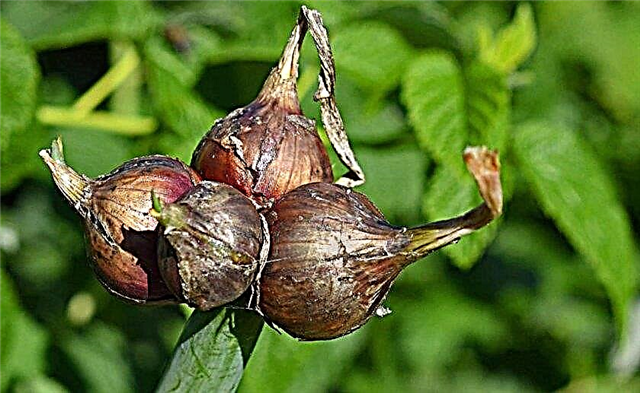
- the dark green tubular foliage of the longline hybrid resembles feathers of onion culture. In length, it reaches 45–55 cm and up to 2 cm wide, hollow and juicy, sharper than that of onions, it is used in the preparation of salads;
- all parts of the plant are suitable for food, and onions are used in marinades and pickles;
- the root system of a multi-tiered culture looks like a large, wide bulb-tuber;
- the plant has resistance to harmful factors, and is also able to tolerate low temperatures normally;
- in the first season, the greenery of the crop is cut only 2 times so that the plant can grow stronger; in the second year, up to 3.5 kg of green feathers are removed from an adult plant per vegetation;
- the culture is unpretentious - in the season it is enough to fertilize 2-3 times and weed a couple of times;
- the agricultural technology of longline bulbs is similar to the cultivation of a rod - both an annual plant and a perennial.
Important! It is allowed to grow a multi-tiered onion culture in one place only 5 consecutive seasons, then it is recommended to transplant the culture to a new garden.
The best varieties of multi-tiered onions
Today, the following top super-early and high-yielding varieties exist:
- Chelyabinsk. A variety for one cut from each bush can produce more than 1 kg of green feathers, for one vegetation (from 1 m²) it produces up to 3.5 kg. The bulbs are medium, round-oval, burgundy-violet, sharp in taste, crispy and strong. From 1 m² receive up to 1 kg of bulbs. Also, the Chelyabinsk variety is characterized by a high concentration of ascorbic acid (70 mg per 100 g of green feathers). It has antiseptic and bactericidal activity.
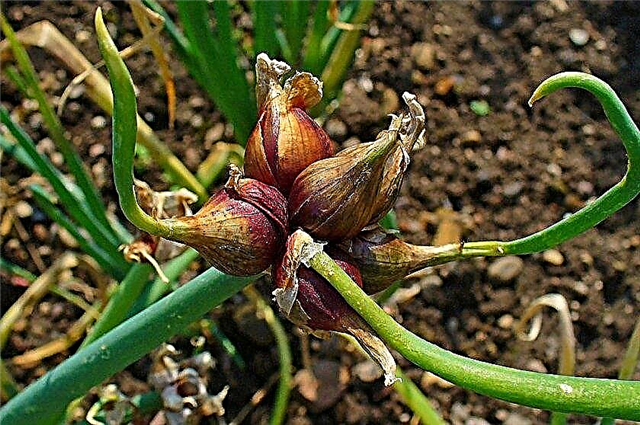
- Memory. During the season, up to 4 kg of green shoots can be collected from onions of the described variety, and over 1.5 kg can be collected in one cut. From 1 m² of planting, up to 750 g of bulbs are harvested. Three to four elongated leaves, sharp in taste, grow from one bulb. 100 g of greens contain on average about 3.5% sugars and 66 mg of ascorbic acid. Strong lilac bulbs are small in size, spicy, crispy.
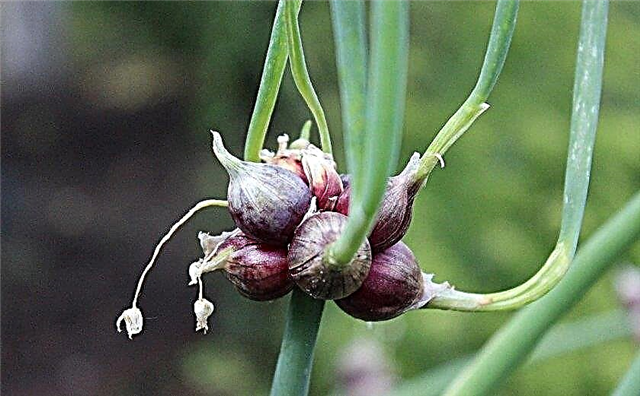
- Likova. The variety is valued for high yields and unpretentiousness. Onions per 100 g of greens contain an average of 73 mg of ascorbic acid, sugar - 3.5%. The fruits have a strong structure, crispy, each weighing up to 7.5 g, are used in pickling. The color of the fruit is from purple to brown-red. Green arrows of this variety have a sharp taste. From 1 m² of crops you can harvest up to 4 kg. Likova variety is resistant to diseases and pests.
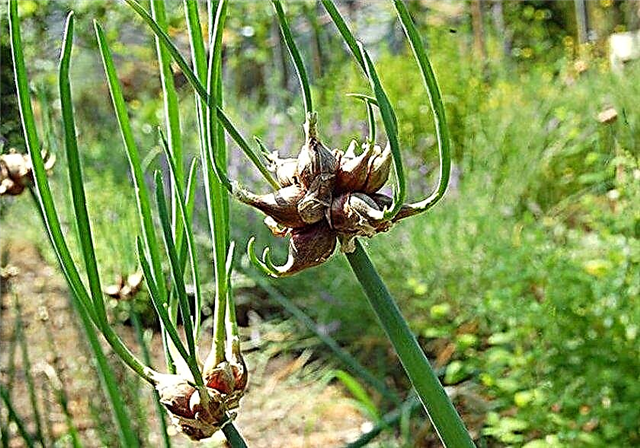
Breeding methods
Tier culture can be propagated in two vegetative ways:
- Underground tubers. The fruits that are in the ground are dug up and divided into separate onions.
- Air bulbs. For this, fruits located on the second or third tier are used.
Important! To get good seeds from an Egyptian onion, you can select two or three onion plants on the bed and not cut off the feather more than 2 times per season.
Outdoor landing
When it comes time to plant multi-tiered bulbs, it is necessary to carefully select and prepare the seeds, adhere to the optimal sowing time and its correct technology.
Selection and preparation of seed
Planting material is collected before the plant releases green arrows.
To do this, adhere to the following rules:
- If it is planned to propagate onions with underground bulbs, the mother tuber, which has grown, is divided into parts. Thus, the seed will be ready for transplanting to a new garden.
- After collecting the fruit, they are sorted by size. It is necessary to calibrate planting material due to the fact that each fraction has its own sowing standards and its own harvesting period, so they need to be sown separately in different beds.

- Fruits harvested in early autumn are suitable for winter planting: they managed to grow roots by this moment and prepared for a long winter period. After the seed is collected, it is thoroughly dried, calibrated, and then folded into a paper bag and sent to the refrigerator or to another cool place.
- For a long-term method of growing plants for propagation, the use of fruits of larger fractions is provided.
Optimal landing times
The culture in question is planted in three terms:
- immediately after the collection (at the end of August or in September);
- before winter (late October - early November);
- early spring (early March).
Important! When planting longline bulbs in the winter, they sometimes do not have time to root well before the first serious frosts, so it is recommended to cover plantings with any covering materials.
Landing technology
In order for the plants not to drown each other, as well as to collect good harvests of onion herbs, you need to know how far each plant is planted from each other.
Experienced gardeners are advised to apply the following planting technology:
- For large seeds, grooves are made with a depth of 8-10 cm, leaving a distance of 25-30 cm between the rows.
- Large bulbs are planted from each other at a distance of up to 20 cm (about 25 pcs are needed per 1 m² of planting material).
- The medium-sized seeds are buried in the soil by about 8 cm, maintaining a distance between plantings of 8-10 cm.
- Seeds of small fraction are buried in the ground by 5 cm, a distance of 6 cm is left between the seeds.
- After sowing the seed material, the soil needs to be moistened, which will accelerate the formation of roots in the seeds.
- The beds with crops need to be mulched with humus for a longer preservation of moisture in the soil.
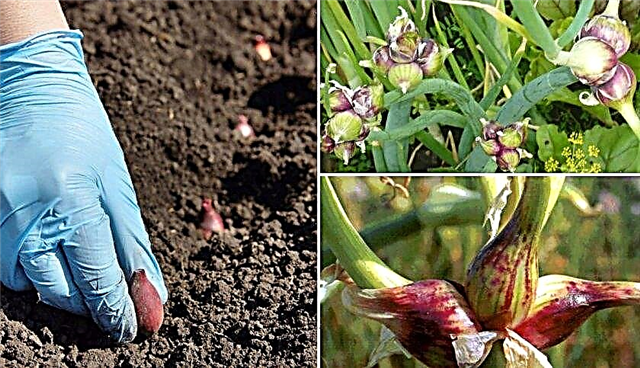
Care for multi-tiered onions
For an uninterrupted supply of greens and bulbs, plants need basic conditions:
- regular watering and top dressing;
- loosening the soil;
- fight against diseases and parasites.
Watering and feeding
Egyptian bulbs are watered according to the following rules:
- Planting a plant requires regular watering with water heated to + 37 ° C.
- Water the crop in the first days after sowing, and then in the dry period.
- After cutting feathers, abundant watering is also required.
- More frequent waterlogging of the soil is undesirable, since increased humidity provokes rotting of plants.
The plants in question also need timely top dressing so that the soil beneath them is saturated with nutrients.
The rules by which to feed the culture:
- Plants are fed after each cutting of greens, alternating organic fertilizers with mineral ones.
- When new greens are growing under the bushes, urea (2.5 g × 1 l of water) should be added.
- A week after the previous top dressing, nitroammophoska (1 g × 1 l of water) or a garden mixture (8 g × 1 l of water) is added.

In order for the green mass to grow intensively, you can add organic dressings for the plants, prepared by yourself:
- from ash - 10 liters of water are mixed with 1.5 tbsp. wood ash, mix thoroughly and poured into the prepared grooves, after which they are covered with earth;
- from mullein - mix 1 liter of manure with 10 liters of water and let it brew for a week, then to prepare top dressing 1 liter of infusion is mixed with 5 liters of water, after which it is carefully watered between rows with the mixture without getting into the greens;
- from chicken droppings - 1 liter of bird manure with 1 liter of water is mixed in a bucket, the dishes are covered and allowed to stand for 3 days; dressing is prepared by dissolving 1 liter of infusion in 10 liters of water, and spacing the aisles, also avoiding getting on the foliage;
- mineral top dressing - complex mineral fertilizer (60 g) is dissolved in 10 l of water and the soil is spilled with this solution in the aisles (1 bucket of solution is designed for 1.5 p. M of garden); in rainy weather, mineral fertilizer is scattered next to the plants (50 g / 1 m²).
After top dressing, it is recommended for plants to arrange a sprinkling procedure to remove splashes of nutrient mixtures that may have got on the plants (to prevent burns).
Did you know? During the Crusades, the bulbs not only entered the menu of every noble knight, but also served as an exchange item as a ransom of compatriots who were captured by the Saracens, for each of which a fee was paid — 8 onions.
Soil loosening
The culture does not like the presence of weeds, therefore, it is necessary to carry out the cultivation of beds with onion plantings, which helps in the fight against them. Also, the procedure will contribute to better soil aeration. Loosening is recommended to be combined with pruning, when plants need extra strength to grow new green mass. Also, loosening is combined with fertilizing the culture.
Pest and Disease Control
The main disease that affects the garden crop in question is a fungal disease peronosporosis. This fungus affects the root system, the bulbs themselves and greens. As a result of the disease, the feathers begin to turn yellow, and the entire planting of the vegetable in the garden is affected. This threatens premature death in all green plants, underdevelopment of bulbs and a decrease in their number. The disease can be prevented if, for the purpose of prevention, spraying of plantings with Bordeaux liquid is used (1% solution).
The main pest of multi-tiered bulbs is considered onion flylaying eggs next to plants or between their leaves. The larvae emerging from the eggs infect the fruit, from which they then rot. To protect the plantation from the pest, spraying with insecticides is used (Diazinon, Tiametoksam, Ripkord, Tsipermetrin according to the instructions).
Features of harvesting and storage of crops
Harvesting a multi-tier has its own characteristics:
- During the growing season, you should not cut feathers from plants more than 2 times, as this can lead to a decrease in the number of air bulbs.
- The first harvest is received after 2.5 weeks from the moment of sowing.
- The second cleaning is carried out as new feathers grow (usually 3 weeks after the first cutting of greenery).
- If an annual onion is planted, the crop is harvested in two strokes - first feathers are cut, and air onions are harvested in the fall, after which the bushes are pulled out and disposed of.
- The upper onions fully ripen in August.
- High yields are obtained from biennial plants - approximately 1 kg of fruit per 1 m² of plantings.

- After harvesting, the onions must be calibrated for planting or pickling for culinary purposes.
- Storage rooms should be dry and adequately ventilated.
- Long storage longline onions can not tolerate, although in the refrigerator, in the vegetable compartment, the fruits can be stored fresh for up to 2 months.
- Bulbs collected for planting are stacked in wooden boxes with sand and stored for no more than 3-4 months in a cool place with a temperature of –3 ... + 2 ° С (in the basement or cellar) and humidity 75%.
By trying to grow multi-tiered bulbs on your site, you will see that this is one of the best perennial crops that can provide you with a long period of high yields of vitamin greens to the table.









